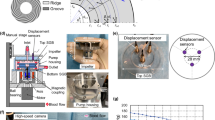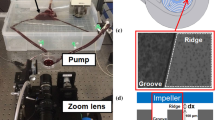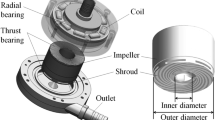Abstract
Plasma skimming can exclude red blood cells from high shear regions in the gaps formed by hydrodynamic bearings in rotary blood pumps. We investigated the effect of the gap size and groove design on the plasma skimming efficiency. Spiral groove bearings (SGBs) were installed into a specially designed test rig for in vitro experiments performed using human blood. The measured gap between the ridges of the bearing and the rotor surface was 17–26 µm at a flow rate of 150 ml/min and a rotor speed of 2400 rpm. Three different patterns of SGBs were designed (SGB-0, SGB-30, and SGB-60) with various degrees of the circumferential component. The hematocrit measured by a high-speed camera was compared with the hematocrit in the circuit, and the plasma skimming efficiency for the three bearing patterns was evaluated at hematocrits of 20%, 25%, and 30%. SGB-60, which had the strongest circumferential component, provided the best plasma skimming efficiency. When the gap size was less than 20 µm, the red blood cells in the gaps between the ridges of the bearing and rotor surface reduced significantly and the efficiency became higher than 90%. The gap size had the strongest effect on producing a significant plasma skimming. The plasma skimming efficiency can be significantly improved by optimizing the bearing gap size and groove design, which facilitates the further development of SGBs for use in applications such as rotary blood pumps.




Similar content being viewed by others
References
Berk ZBK, Zhang J, Chen Z, Tran D, Griffith BP, Wu ZJ. Evaluation of in vitro hemolysis and platelet activation of a newly developed maglev LVAD and two clinically used LVADs with human blood. Artif Organs. 2019;43:870–9.
Hijikata W, Maruyama T, Murashige T, Sakota D, Maruyama O. Detection of thrombosis in a magnetically levitated blood pump by vibrational excitation of the impeller. Artif Organs. 2020;44:594–603.
Tsukiya T, Mizuno T, Takewa Y, Tatsumi E, Taenaka Y. Preclinical study of a novel hydrodynamically levitated centrifugal pump for long-term cardiopulmonary support: in vivo performance during percutaneous cardiopulmonary support. J Artif Organs. 2015;18:300–6.
Kosaka R, Yada T, Nishida M, Maruyama O, Yamane T. Geometric optimization of a step bearing for a hydrodynamically levitated centrifugal blood pump for the reduction of hemolysis. Artif Organs. 2013;37:778–85.
Kosaka R, Maruyama O, Nishida M, Yada T, Saito S, Hirai S, Yamane T. Improvement of hemocompatibility in centrifugal blood pump with hydrodynamic bearings and semi-open impeller: in vitro evaluation. Artif Organs. 2009;33:798–804.
Kink T, Reul H. Concept for a new hydrodynamic blood bearing for miniature blood pumps. Artif Organs. 2004;28:916–20.
Kosaka R, Yasui K, Nishida M, Kawaguchi Y, Maruyama O, Yamane T. Optimal bearing gap of a multiarc radial bearing in a hydrodynamically levitated centrifugal blood pump for the reduction of hemolysis. Artif Organs. 2014;38:818–22.
Han Q, Zou J, Ruan X, Fu X, Yang H. A novel design of spiral groove bearing in a hydrodynamically levitated centrifugal rotary blood pump. Artif Organs. 2012;36:739–46.
Kosaka R, Sakota D, Nishida M, Maruyama O, Yamane T. Improvement of hemolysis performance in a hydrodynamically levitated centrifugal blood pump by optimizing a shroud size. J Artif Organs. 2021;24:157–63.
Palmer AA. Axial drift of cells and partial plasma skimming in blood flowing through glass slits. Am J Physiol. 1965;209:1115–22.
Leslie LJ, Marshall LJ, Devitt A, Hilton A, Tansley GD. Cell exclusion in Couette flow: evaluation through flow visualization and mechanical forces. Artif Organs. 2013;37:267–75.
Murashige T, Sakota D, Kosaka R, Nishida M, Kawaguchi Y, Yamane T, Maruyama O. Plasma skimming in a spiral groove bearing of a centrifugal blood pump. Artif Organs. 2016;40:856–66.
Sakota D, Kondo K, Kosaka R, Nishida M, Maruyama O. Plasma skimming efficiency of human blood in the spiral groove bearing of a centrifugal blood pump. J Artif Organs. 2021;24:126–34.
Muijderman EA. Spiral groove bearings. Ind Lubr Tribol. 1965;17:12–7.
Eckmann DM, Bowers S, Stecker M, Cheung AT. Hematocrit, volume expander, temperature, and shear rate effects on blood viscosity. Anesth Analg. 2000;91:539–45.
Amaral F, Egger C, Steinseifer U, Schmitz-Rode T. Differences between blood and a Newtonian fluid on the performance of a hydrodynamic bearing for rotary blood pumps. Artif Organs. 2013;37:786–92.
Hori Y. Hydrodynamic lubrication. 1st ed. Japan: Springer; 2006.
Najar FA, Harmain GA. Numerical investigation of pressure profile in hydrodynamic lubrication thrust bearing. Int Sch Res Notices. 2014;2014:157615.
Murashige T, Kosaka R, Sakota D, Nishida M, Kawaguchi Y, Yamane T, Maruyama O. Evaluation of a spiral groove geometry for improvement of hemolysis level in a hydrodynamically levitated centrifugal blood pump. Artif Organs. 2015;39:710–4.
Amaral F, Gross-Hardt S, Timms D, Egger C, Steinseifer U, Schmitz-Rode T. The spiral groove bearing as a mechanism for enhancing the secondary flow in a centrifugal rotary blood pump. Artif Organs. 2013;37:866–74.
Wu Y, Zhu L, Luo Y. Design and hemocompatibility analysis of a double-suction injection suspension blood pump using computational fluid dynamics methods. Artif Organs. 2017;41:979–87.
Li X, Peng Z, Lei H, Dao M, Karniadakis GE. Probing red blood cell mechanics, rheology and dynamics with a two-component multi-scale model. Philos Trans A Math Phys Eng Sci. 2014;372:20130389.
Lee TR, Yoo SS, Yang J. Generalized plasma skimming model for cells and drug carriers in the microvasculature. Biomech Model Mechanobiol. 2017;16:497–507.
Acknowledgements
This work was partly supported by the Grant-in-Aid for Scientific Research (KAKENHI) Grant Number 20H02098 and 20J14805.
Author information
Authors and Affiliations
Corresponding author
Ethics declarations
Conflict of interest
The authors declare that there is no conflict of interest with respect to this study.
Additional information
Publisher's Note
Springer Nature remains neutral with regard to jurisdictional claims in published maps and institutional affiliations.
Rights and permissions
About this article
Cite this article
Jiang, M., Sakota, D., Kosaka, R. et al. Impact of gap size and groove design of hydrodynamic bearing on plasma skimming effect for use in rotary blood pump. J Artif Organs 25, 195–203 (2022). https://doi.org/10.1007/s10047-021-01308-x
Received:
Accepted:
Published:
Issue Date:
DOI: https://doi.org/10.1007/s10047-021-01308-x




